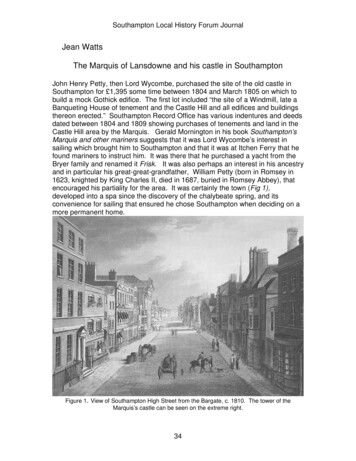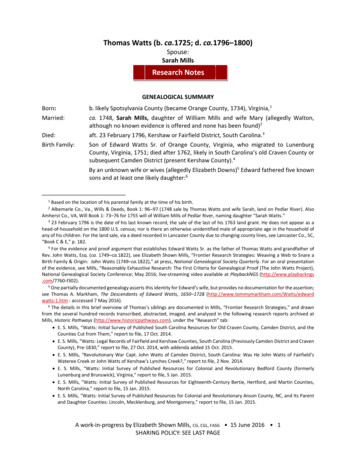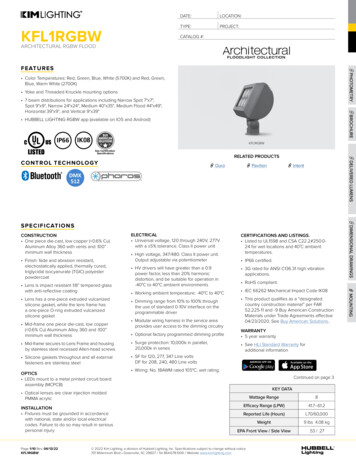
Transcription
Southampton Local History Forum JournalJean WattsThe Marquis of Lansdowne and his castle in SouthamptonJohn Henry Petty, then Lord Wycombe, purchased the site of the old castle inSouthampton for 1,395 some time between 1804 and March 1805 on which tobuild a mock Gothick edifice. The first lot included “the site of a Windmill, late aBanqueting House of tenement and the Castle Hill and all edifices and buildingsthereon erected.” Southampton Record Office has various indentures and deedsdated between 1804 and 1809 showing purchases of tenements and land in theCastle Hill area by the Marquis. Gerald Mornington in his book Southampton’sMarquis and other mariners suggests that it was Lord Wycombe’s interest insailing which brought him to Southampton and that it was at Itchen Ferry that hefound mariners to instruct him. It was there that he purchased a yacht from theBryer family and renamed it Frisk. It was also perhaps an interest in his ancestryand in particular his great-great-grandfather, William Petty (born in Romsey in1623, knighted by King Charles II, died in 1687, buried in Romsey Abbey), thatencouraged his partiality for the area. It was certainly the town (Fig 1),developed into a spa since the discovery of the chalybeate spring, and itsconvenience for sailing that ensured he chose Southampton when deciding on amore permanent home.Figure 1. View of Southampton High Street from the Bargate, c. 1810. The tower of theMarquis’s castle can be seen on the extreme right.34
Southampton Local History Forum JournalBut why he chose to build on a brownfield site in a cramped area of town ratherthan in what the guidebook of the time calls “the salubrious environs” is perhapspart of his somewhat quixotic character.Lord Wycombe (Fig 2) - he only becameMarquis of Lansdowne on the death of hisfather in 1805 – was born on 6 December1765. His mother died in 1771 when he wasonly five years old, and his younger brother,William, died at the age of nine. His father,Lord Shelburne, who became Marquis ofLansdowne in 1784, went abroad for a longperiod after his first wife’s death, so it musthave been a very lonely childhood. He wasthirteen when his father married for a secondtime in 1779. Lord Shelburne was an ableman with a wide range of interests and wasa patron of the arts and sciences, but hewas not a popular man. The OxfordDictionary of National Biography says“though possessed of great abilities he waswanting in tact, and without any skill in themanagement of men.” He was what weFigure 2. Earl of Wycombe in 1796would now call a control freak and wanted to direct his son’s life in the manner inwhich, he the father, planned. Of course, this did not bode well for good relationsbetween the two men and no doubt contributed to some extent to LordWycombe’s refusal to follow the political career mapped out for him. The Timesreported in December 1786 that “[Lord Wycombe] is said to be a youngnobleman of very promising talents, and who has, by the judgment and wisdomof his father, been trained and educated in a line that at present bids fair to makehim an honour to himself and an advantage to his country.” This prediction wasnot to be fulfilled. He was Member of Parliament for High Wycombe, he didattend the House of Commons and spoke there occasionally but he spent aconsiderable time abroad. Indeed he was probably one of the most widelytravelled members of Parliament having visited France, Sweden, Spain, Italy andthe nascent United States where he met George Washington and could haveused these experiences to greater effect.The Earl chose to travel, to sail (becoming a very hands-on sailor according toGerald Mornington) and to follow his own interests. The Times on 30 July 1792notes that “Lord Wycombe is now at sea in a cutter of his own, and she is bothably manned and elegantly freighted.”. He pursued an enthusiasm for nauticalexperiments, obviously influenced by Sir William Petty’s invention of a doublebottomed boat. As Lady Betty Craven notes in 180635
Southampton Local History Forum Journal“The Marquis of Lansdowne, who was extremely fond of aquaticexcursions and delighted in nautical experiments, had prepared a vessel,which he had built at Southampton under the superintendence of a skilfulengineer. . His Lordship wished to try how the vessel would sailwithout ballast, it being double bottomed.”Unfortunately the experiment did not go well and the boat capsized leaving LadyBetty Craven to raise the alarm.Lady Holland, a friend and correspondent of both father and son commented in1799: “Arduous would be the attempt to decipher Lord Wycombe’s character.The most predominant feature is the love of singularity.” Another example of hiscontrary ways is described is this quote from The Times written in February 1863at the time of the death of his half-brother, the third Marquis, “In London he [thesecond Marquis] was a marked man – remarkable for his disregard of dress, andfor the pride he took in appearing on the coldest days in winter without a greatcoat and without gloves.”Perhaps the impetus to build something permanent at Southampton was a resultof Lord Wycombe meeting Lady Giffard, wife of Sir Duke Giffard, a baronet withan estate in County Meath. This occurred in the later stages of his affair with MrsWyndham, wife of Hon. Frederick William Wyndham, British minister in Florence.She had followed Lord Wycombe to Dublin and the affair was a matter of concernto his father. Indeed Mr Wyndham took him to court in 1800 for criminalconversation, a civil suit brought by a husband against the lover for trespass; inshort, suing the lover for monetary damages. The case was found non-suited butthe anxiety and time taken up with visits to Italy to secure witness statementsmust have taken their toll. In 1802 Sir Duke Giffard died but his widow and LordWycombe did not marry until 1805. The first Marquis had died on 7 May that yearand the couple married in London only a few days later. It is possible that theywere planning their marriage and their new home in Southampton between 1802and 1804. Lady Bessborough was perhaps voicing the views of the many whenshe wrote that the new Marchioness was “a vulgar Irish woman near fifty andlarger than Mrs Fitzherbert (at least, this is the account given of her). I suppose itis point d’honneur, for she has liv’d with him publickly as his Mistress for someyears past.”It would be extremely neat if it could be proved that the architect John Plaw wasresponsible for the design of the castle. John Plaw moved to Southampton in1797 before emigrating to Canada in 1807. He is said to have designed theBarracks building still standing at the old Ordnance Survey offices in LondonRoad and also planned buildings in Albion Place. Certainly there is mention indeeds and conveyances of “John Plaw, architect, a trustee appointed by theMarquis of Lansdowne”, and it is possible that he and the Marquis were involvedtogether in building plans – perhaps the castle, perhaps Albion Place or otherareas in the town. This may account for references in correspondence36
Southampton Local History Forum Journalconcerning the Marquis’s gift of the statue of George III in 1809. In August thatyear, writing to offer the statue to the corporation, the Marquis mentions “the highsense I entertain of the disposition to accommodate me which the gentlemen ofthe Corporation were pleased to manifest with a reference to my presentundertakings.” The Town Clerk is instructed to reply“ . the sentiments your Lordship have been pleased to entertain of thedisposition manifested by the gentlemen of the Corporation towards you,in reference to your buildings in this Town conscious as they are, thatin accommodating your Lordship no injury or inconvenience has beensustained by the public.”This suggests that there was a helpful atmosphere in which business matterscould be decided to the mutual satisfaction of both the Marquis and thecorporation.One architect who did work for the Marquis was John Linnell Bond, responsiblefor “a room erected at Southampton Castle for the Marquis of Lansdowne afterthe manner of the Moorish architecture of Granada.” Despite the magnificence ofthe castle as shown in Fig. 3, it did have drawbacks as an anonymous writer inthe Gentleman’s Magazine in September 1809 states:“[the castle] is built with brick, covered in white composition. The roundtower and upper apartments command a fine view of the SouthamptonEstuary, the river Itchen and the surrounding country but it has no groundand the base is entirely blocked up with small houses belonging to thepoorer inhabitants.”Skelton’s Guide notes that the apartments “are more remarkable for theirsingularity, than for their size, or their magnificence.” The kitchen, measuring 39feet by 20 feet is thought to be “scarcely inferior to that belonging to his grace theduke of Norfolk, at Arundel.” There is a “truly Gothic” dining room measuring 40feet by 20 feet containing a life size portrait of George III in painted glass.Although the Marquis and Marchioness are reported to be in residence in theircastle as early as 1805, it would seem that the building of the castle was work inprogress as this quote from the Observer in 1809 suggests.“The Marquis of Lansdowne’s Gothic Castle at Southampton, which wecannot help considering as a proof of the wealth rather than the taste ofthe owner, is carrying on with spirit; and yet we question whether part ofthe work will last until the whole is finished, another settlement havinglately been discovered in the advanced South Wall, and that weightymass of masonry is prevented, by props, from burying in ruins itsbeggarly neighbourhood.”37
Southampton Local History Forum JournalEven after his death building continued,as was reported in Skelton’s Guide in1815, “In its present state, SouthamptonCastle must be regarded as an incompletestructure, but very considerable additionsare now going forward.” Perhaps noarchitect would wish, from a professionalviewpoint, to be associated with a buildingthat appeared already to be in danger ofcollapse.Regardless of the castle’s state and sitethe town at least was happy to enjoy thehospitality of the noble couple and togossip about their activities. Royalpatronage had moved elsewhere by theend of the 18th century and thecorporation was hoping that visits to hiscastle by the Marquis would renewSouthampton’s attractions and, havingFigure 3. Southampton Castle, c. 1806made him an honorary burgess, their hopes appeared to be realised when theHampshire Chronicle reported in August 1805, “The vast number of gentryconstantly visiting at the Castle, and the spirited conduct of its noble owner, bidfair to be productive of general good to this town.” Again according to theHampshire Chronicle the Marquis and his wife attended the races in 1806, “withelegant new carriages and liveries, displayed a most brilliant appearance on therace ground.” In August 1807 the Chronicle reported that“. the inhabitants were spectators of the grandest illumination that hasever taken place in this town. The Marquis and Marchioness ofLansdowne gave a grand fete . to a grand assemblage of high life andfashion. The internal appearance of the Castle was beautiful beyonddescription; the superb windows of stained glass, and the vast number ofglass lamps on the outside displayed a very magnificent appearance asdid also the display of the table before supper, the doors having beenthrown open for the gratification of the public.”The Marquis in his castle was therefore an economic asset to the town, andwelcomed by the corporation.Unfortunately this happy state of affairs was not to last. The Marquis died on 15November 1809 at his London house. He had been suffering from a livercomplaint for some time and his physicians’ prescription of mercury can surelyonly have hastened his end. His widow continued to visit Southampton andagain it is obvious that work on the castle was still on-going. In October 1811,38
Southampton Local History Forum JournalLady Bessborough, perhaps forgetting the acerbic comments she had made atthe time of the Marchioness’s marriage, wrote that she went “to see the strangehouse Lord Landsowne built here”. She reports the Marchioness had told herthat“near a hundred houses belong to her and are to be pulled down. It mustalready have cost many thousands and will many more It is howevera great ornament to the town which it overtops; the view is as beautiful asa bird’s eye view can be, and the rooms are crowded with fine things ofevery description brought from Lansdowne House”.However, in July 1816 the“valuable and well-conditionedmaterials of the SpaciousCastle at Southampton”, whichhad been “erected at animmense expense”, were soldat auction. Lots included a“handsome black and yellowmarble solid gothic chimneypiece in the Dining Room, apair of large and capitalpointed gothic folding doors 13feet by 6 feet 2 studded withiron, large lock and key, 4brass flush bolts with knobs, 2of ditto 6 feet in length, 2 brasshandles, and the largemoulded frame with 2 Portlandstone plinths and long stepbetween” from the Grand Hall.Also “the very large andhandsome carved statuarymarble chimney piece ofexquisite workmanship, the two4 feet pilasters in solid statuary6 inches in diameter, carved inimitation of Roman Fasses,bound together with the battleaxe, and covered withFigure 4. Front page of catalogue for sale of castle, July1816 Wiltshire & Swindon Archives, 451/226large enriched helmets” in the Drawing Room. Not all lots were of such quality ormagnificence. In addition to vast quantities of lead, brickwork, Purbeck andPortland stone, there was the brickwork forming two melon pits in the garden, the39
Southampton Local History Forum Journalcomplete erection of the wood and glass forming the Grape House and Pinery,stables, hayloft, icehouse and the “patent water closet and apparatus fitted up indeal with the bason [sic], service and soil pipe and cistern lined with lead” in theservants’ quarters.At the same time the site was to be sold by auction “the Freehold Scite [sic] ofthe Castle, four brick tenements, and the Garden with a front of 277 feet next theriver.” The site was eventually sold, the mound lowered slightly and the ZionChapel erected there in 1823.Thus the castle was sold for salvage, its material carted away by architects,builders, carpenters and anyone with an eye for a bargain. Some of thebrickwork and stonework must have found its way within the town to repair orrebuild houses. However, it is possible that some identifiable items may still befound in the vicinity. Hamble Cliff House is situated on the shores ofSouthampton Water just below what is now the Victoria Country Park. Accordingto P Campion in A Recent History of Hampshire, Wiltshire, Dorset published aspart of the Wessex Series in c1923, it was built in 1809, “The stone used in theconstruction of the house, the massive Gothic design oak doors and the rareexamples of mullioned windows and tracery are all of an earlier date than 1809and were probably brought from Southampton Castle.” It is possible that thematerials came from what was left of the original castle. However, looking atHamble Cliff House it is easy to picture the stone windows with their gothicpointed tracery as coming rather from the salvage sale, in which case the 1809date would seem to be incorrect.Another possible piece of architectural salvage from the castle may have foundits way to Romsey. In the proceedings of the Southampton Rambling Club in1913 Mrs Suckling, local historian, took members round Romsey and reported“Mr Curtis allowed his garden to be seen. It stands on a portion of the site of theAbbey paradise. One of the windows in the house came from SouthamptonCastle.” According to Kelly’s directory of 1915 Josiah Curtis, glove and gaitermaker occupied 6 Church Street. It is now the Marie Curie Cancer Shop and it ispossible the window referred to stands behind the till.The block of flats, Castle House, now stands on the site of the Marquis’s castle.Its inhabitants must enjoy the same views as did the Marquis in the rooms andtowers of his home. It is tempting to wonder what would have happened had notthe Marquis died so young. It is doubtful that the castle was structurally strongenough to survive for many years. Its building seems to be at one with theMarquis’s idiosyncratic nature and would surely have become a white elephantbefore too long. Nevertheless, the castle and its owner and family must haveproved a great, if only short-lived, ornament and interest to the town.40
the castle as shown in Fig. 3, it did have drawbacks as an anonymous writer in . feet by 20 feet containing a life size portrait of George III in painted glass. Although the Marquis and Marchioness are reported to be in residence in their castle as early as 1805, it would seem that the building of the castle was work in .










